SARDINIA, GIANTS, AND THE ORION CONNECTION
The Nuraghe, or Towers of the Giants, point to a missing Mediterranean civilization on this island.
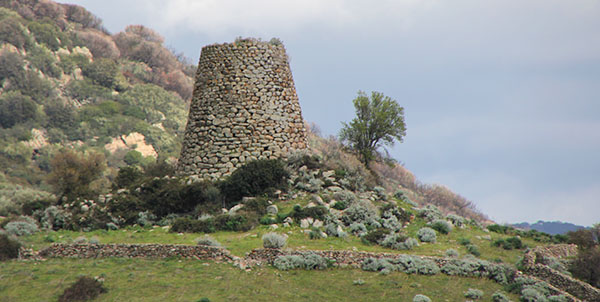

Sardinia. One of the most geologically ancient lands in Europe, inhabited during the Upper Palaeolithic, home to a Nuragic civilization that left nothing behind by way of writing. Folklore paint these people as seafarers, perhaps mercenaries — Srdn-w, as recorded in 16th century BC Egyptian texts — who may have originated from Asia Minor.
Then there’s Sardinian language. Many words, dialects, names of mountains and rivers have no basis in Greek, Latin or Punic, nor Semitic or pre-Indo European. They do, however, show analogies with Basque and North Libyan languages and dialects along the Danube. Given that Sardinians’ physiognomy is also the most dolichocephalic, with a high incidence of long heads, and the DNA of its population from 10,000 BC surviving in the present population — a unique genetic heritage — suggests their language may be a remnant of a former, and now lost, civilization.
Even more mysterious are the thousands of towers and tombs of the giants, the former named nuraghe, except no published source informs us of how these unusual structures, many of which are based on megalithic stonework, came to be associated with tall people. As to their age, historians and archaeologists place them anywhere between 3500-1500 BC and yet no carbon dating has been performed to validate this range. Like nearby Malta, the sites have been arbitrarily allocated a period that best fits the academic consensus, one that relies on pottery shards or animal bones among the dirt inside these structures. Realistically, the people who built such impressive temples would also have kept them clean, free of debris, thus what archaeologists are dating is the period long after the sites fell out of use, a period of decline when they accumulated debris, and began to be used for purposes that may have differed from their original intent. By this logic, if the lowest habitation layer is dated to 3500 BC, the site itself may be decades or hundreds, even thousands of years older.
It seems that to solve the mystery of the places of the giants we must turn to etymology, local tradition, even archaeo-astronomy, the relationship between a temple and its mirrored stellar object in the sky.

Sa Coveccada, a rare dolmen on Sardinia.
THE ORIGIN OF NURAGHE
On my recent journey to Sardinia I researched the origin of the word nuraghe. It is certainly alien to the country, appearing instead in the Maltese language, itself an amalgam of Arabic, Hebrew, near eastern and north African languages. Nur means ‘just or rightful people’; its origins lie in Armenian and Azerbaijani, adjoining nations in the south Caucasus region, where it also means ‘light or shining’; aghe, its root ag in particular, means ‘white’. Together we can extrapolate the meaning of nuraghe, tower of the giants, as ‘a place of assembly of the just or rightful, white, shining people’. Who these sages might have been we’ll come to in a moment.
By the time the Greeks arrived in Sardinia, only myths remained of the islanders being the rudimentary progeny of earlier god-men. Diodorus Siculus himself compiled much on this topic, including the persistent myth that the island was once associated with Heracles, a flood era god-man. The story goes that after Heracles performed his twelve labours, the gods told him that before he passed into their company he should create a colony in Sardinia and make his sons the leaders of the settlement, which he did, along with Iolaus, father of his charioteer. It is important to understand that myth was a theatrical mechanism used to encode valuable historical information in a manner that assisted the memorializing of important events. Although the language and symbolism may sometimes be obtuse to us today, the events and people portrayed in the stories are nevertheless faithfully recorded for posterity.
Heracles was half human, half divine, borne of the mating of a god with a human woman (Zeus in the Greek tradition, although the Greek gods were variants on older Egyptian and Sumerian prototypes). The hero’s overcoming of natural forces, monsters and his own inner urges mark him as an initiate. Since one of his labours was to catch the Cretan Bull, ostensibly Heracles may be the human equivalent of Orion the hunter chasing Taurus the bull. Like his predecessor Osiris, Heracles was associated with the Otherworld as well as fertility, as is Orion. The point to bear in mind is that Orion is a Greek transliteration of the Mesopotamian name Ur-annu (‘light of heaven’), a sage who, as his surname suggests, was part of a group of enlightened gods named the Lords of Anu, also known as Tuadhe d’Anu and Anunaki (People of Anu).
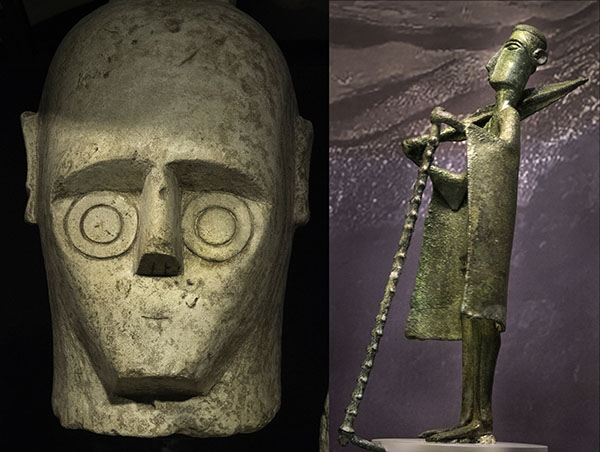
Tall people and elongated heads differ from standard Sardinian physiognomy. The oversized eyes are symbolic of an enlightened elite of sages, and often used in ancient cultures from Asia Minor to Polynesia to depict gods.
HERACLES THE ANUNAKI?
As an aside, the Anunaki have been given an undeservedly negative image, and nothing could be further from the truth if one cares to read the surviving texts regarding their origin and aim. They also went by the collective title Apkallu (‘sage’). Incidentally, the Mesopotamian flood narrator Gilgamesh is associated with Orion and, like Heracles, was part human part Apkallu, while the hero of the story, Utnapishtim, was descended from the Apkallu and bore the title Unsurpassed in Wisdom.
Because the Apkallu/Anunaki had a habit of applying oil to their skin they were nicknamed Shining Ones; as a metaphor the title also defined their intellectual and spiritual capacity. They were described as exceptionally tall, white or light-skinned, with blue or green eyes, and appear to have once lived in the south Caucasus region.
If we compare these facts with the meaning of nur-ag or nuraghe we can begin to see a connection developing as to whom the Sardinians were referring to as the builders of the towers and graves of the giants. Let’s now take this a stage further and identify a potential date range for the construction of their monuments.
Whether we are dealing with a pyramid, a dolmen or a passage mound, megalithic architects generally memorialized the date of construction when they aligned their monuments to the Sun, Moon, or a particular star or constellation. Perhaps the most publicized example is Robert Bauval and Adrian Gilbert’s discovery of the Giza pyramids mirroring Orion’s Belt on the spring equinox of 10,400 BC, and the associated symbolism conveyed by this date. It is also true that many monuments are aligned to face the winter solstice and spring equinox sunrise for reasons that are at the same time symbolic, ritualistic as well as practical. And yet after analyzing two dozen arbitrary sites throughout Sardinia I was surprised to find that only a quarter referenced the winter solstice or equinox sunrise, even the lunar standstill; fewer still referenced said markers during the period in which they are claimed to have been built.
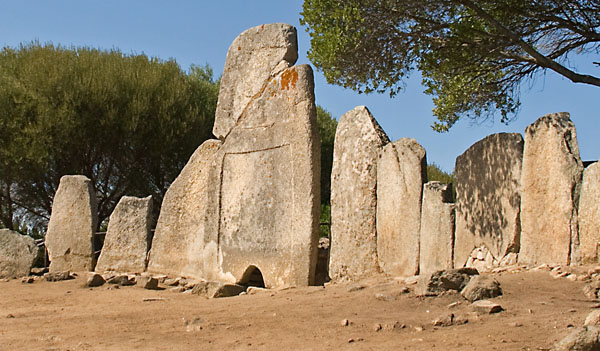
Li Loghi, a typical Giant’s Grave. It faces the winter solstice in 8500 BC.
DATING SARDINIAN TEMPLES
One site that did stand out was the giant’s grave Imbertighe, with its curved forecourt and fifteen-foot tall phallic entrance stella. In 3700 BC it was aligned to the winter solstice sunrise, placing it in the Neolithic era. However, if the suggestion that these sites are much older is correct, then by the natural process known as precession, the same entrance would have aligned to the equinox sunrise in 8500 BC, closer to the period when the Anunaki are known to have inhabited various locations around the Earth; as the Aku Shemsu Hor (Shining Ones, Followers of Horus) they had already established the sacred mounds along the Nile by 10,400 BC.
The 8500 BC date also occurs at Li Loighi, on the winter solstice.
It was at this point I learned of the enduring association throughout Sardinia between the giants graves and towers of the giants with Orion, and Sirius, the star of wisdom that follows said constellation in the sky. Taking into account the orientation of the sites and their relationship to their respective horizons, remote dates began to emerge for the giants graves: Iloi and Osono, Orion at mid-heaven position on the winter solstice, 7200 BC; Orrida, Orion rising on the winter solstice 5200 BC and Sirius 4800 BC; Sa Domu ‘e s’Orcu, Orion’s Belt on the winter solstice 5000 BC; Cuiledda Dolmen and Su Monte ‘e S’Abe, Orion and Sirius on the winter solstice 4000 BC. Clearly we are looking at a continuous tradition.
But it was the towers of the giants that yielded the most surprises. These round, tapering edifices tend to be founded on megalithic stonework, upon which millennia of earthquakes and warfare have necessitated periodic rebuilding using progressively smaller, and more practical masonry — exactly like the valley temples of Egypt or the Andean temples which, coincidentally, are claimed to have been built by exactly the same brotherhood under different names, such as Viracocha and his Hayhuaipanti (Shining Ones) in the Andes. Many of the towers are equipped with light boxes, useless as defensive mechanisms but useful for marking a specific heavenly body. Their interiors all feature the same beehive design which any architect would correctly agree makes for effective distribution of weight and a tall ceiling (some can be as high as 39 feet). However, the beehive, like the bee, was one of the symbols associated with the Tuadhe d’Anu, from the Middle East all the way to the Scottish Isles, where they were later known as Tuatha de Danaan, still described as very tall master astronomers with fair skin.
One excellent example is Nuraghe Corbos a Silanus, a perfect example of a tower featuring only a small light box as illuminator along with a tiny entrance. It is aligned to Orion and Sirius rising on the winter solstice in 6500 BC. As is Pira ‘e Zuri and Is Paras. By comparison, Oes may be referencing the same at either 6000 BC or 3000 BC (there is no reliable alignment data).
But the biggest surprise concerns three sites, barely five miles apart along a straight line, the third off center by less than 2º. Together they appear to form a story, least of all because, like the Giza pyramids, they suggest the alignment of the belt stars of Orion: the dolmen Sa Coveccada, unusual in that dolmens are rare in Sardinia; Nuraghe Ruju, a single tower and well preserved at that; and Nuraghe Santu Antine, once a lone tower, later expanded with additional structures, all encompassed within a triangular fortification.

Nuraghe Ruju. The central of three sites that mirror Orion’s Belt c.6000 BC.
TOWERS OF ORION
Let’s begin with Nuraghe Ruju, the middle site, by far the one with the widest view of the inter-cardinal horizon. Ruju appears at first glance to have two entrances, but on closer inspection the lower was the original entrance, while the upper was merely a window. Behind this window is the appropriate beehive chamber, complete with a misaligned niche. This niche narrows the field of view to the horizon, creating a sightline to a distant hill which was artificially flattened as though creating a reference point for an object in the sky. Indeed the object in question is Orion’s Belt, which would have risen above the flattened summit on the winter solstice in the era of 6000 BC.
A short drive southeast we come to the second tower, Santu Antine. If we isolate the original, lone tower from the later exterior additions we are still left with an extraordinary structure. The entrance leads to a tall beehive chamber featuring cloverleaf side rooms; climbing the curving inner staircase we come to a superimposed beehive chamber, perhaps added to maintain an unobstructed view of the horizon. Here, the winter solstice is referenced c.7000 BC, with another distant mountain artificially flattened to allow the descent into the horizon of Orion’s Belt and Sirius in c.6000 BC, essentially marking the end of the trajectory begun earlier at Nuraghe Ruju. Like the Chinese, these Sardinian master astronomers shaped the landscape to allow for beneficial sky-ground relationships with their temples.
Together with Sa Coveccada, the three sites mirror the mid-heaven position of Orion’s Belt as it would have appeared in that era; even its angle of incline relative to the horizon appears to be commemorated on the ground.
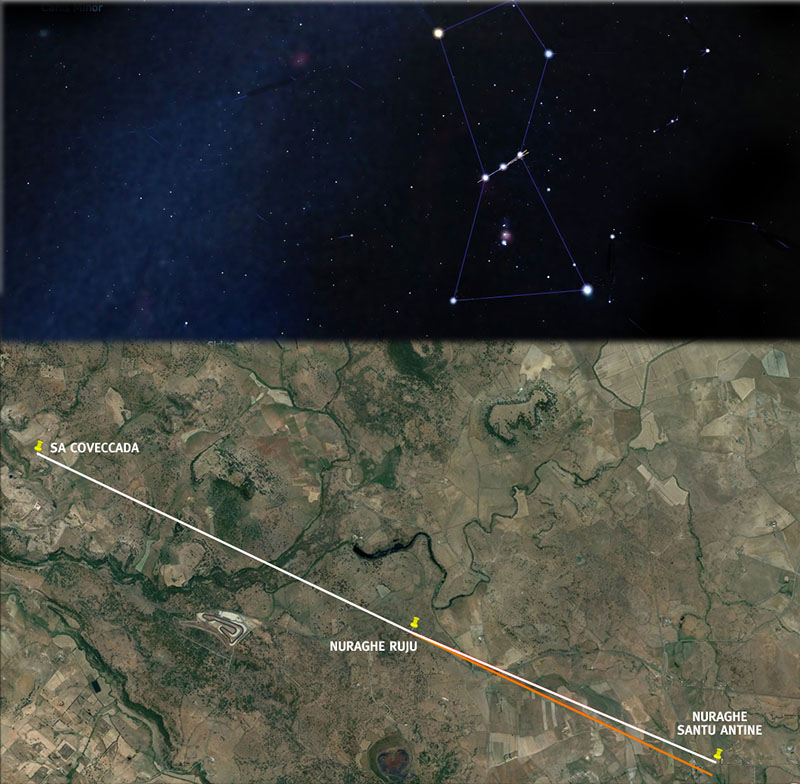
Alignment and location of the three sites closely mirror Orion’s Belt c.6000 BC.
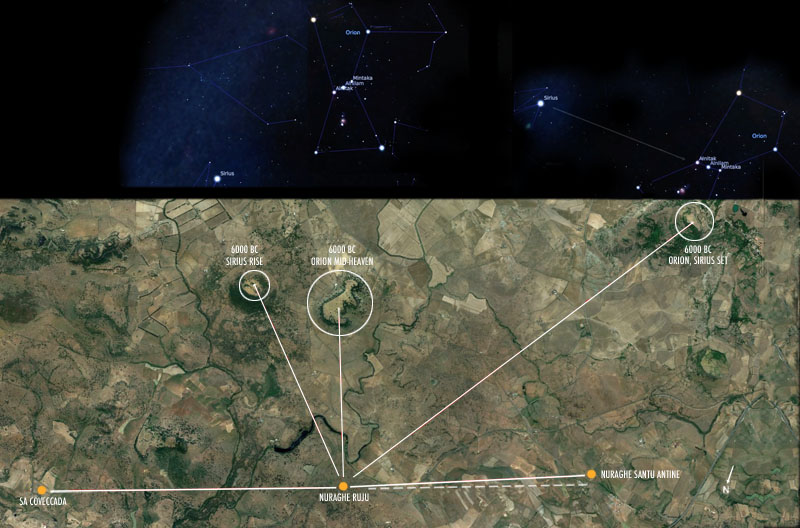
Tracking Orion and Sirius with reference to artificially flatenned summits of hills.
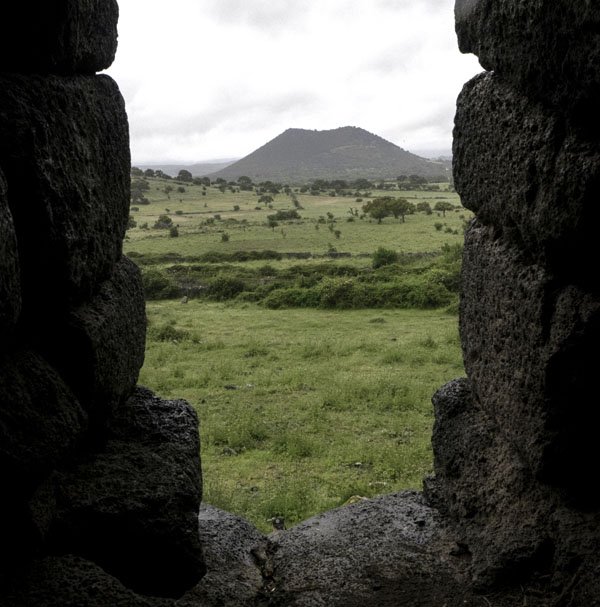
Sightlines to artificial summits referenced by windows in the nuraghe.
But there’s an enigma here. The dolmen Sa Coveccada has suffered considerable damage and has been extensively repaired, and it is quite likely that its original alignment may be off by as much as 10º. This is based on direct observation, and there is no data available to establish the original angle of alignment. This means that, as it stands, the dolmen appears to reference the winter solstice as well as a Minor Lunar Standstill c.5000 BC, close but not close enough to the other two, with Orion not even in the picture; Orion’s Belt finally matches the site c.2600 BC, and this poses a conundrum with my hypothesis.
Or does it? When Bauval and Gilbert’s made their Giza hypothesis, they found that the Great Pyramid’s shafts reference stars in four significant constellations c.2450, in addition to the three pyramids’ ground plan of 10,400 BC. Could it be that the same people applied the same method in Sardinia, matching Orion with the ground plan c.6000 BC, and memorializing a second date at Sa Coveccada in c.2600 BC?
Only another visit to Sardinia can finesse this research, which I plan to do next year. In the meantime we have presented here new ideas on who create the places of the tall, shining people on this unusual island, and when.
Watch my 3-part Series on Sardinia's Prehistory on GaiaTV.
© Freddy Silva 2019